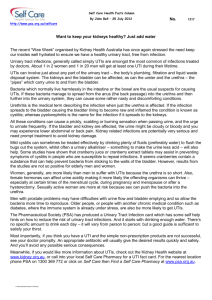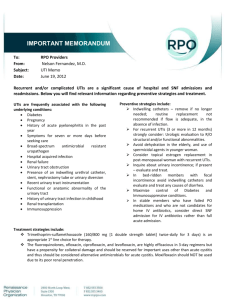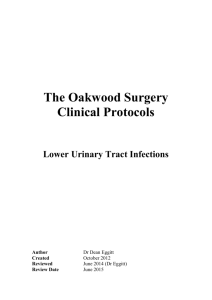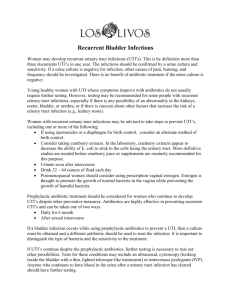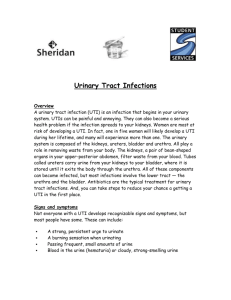General Medical Officer (GMO) Manual: Urinary Tract Infections
advertisement
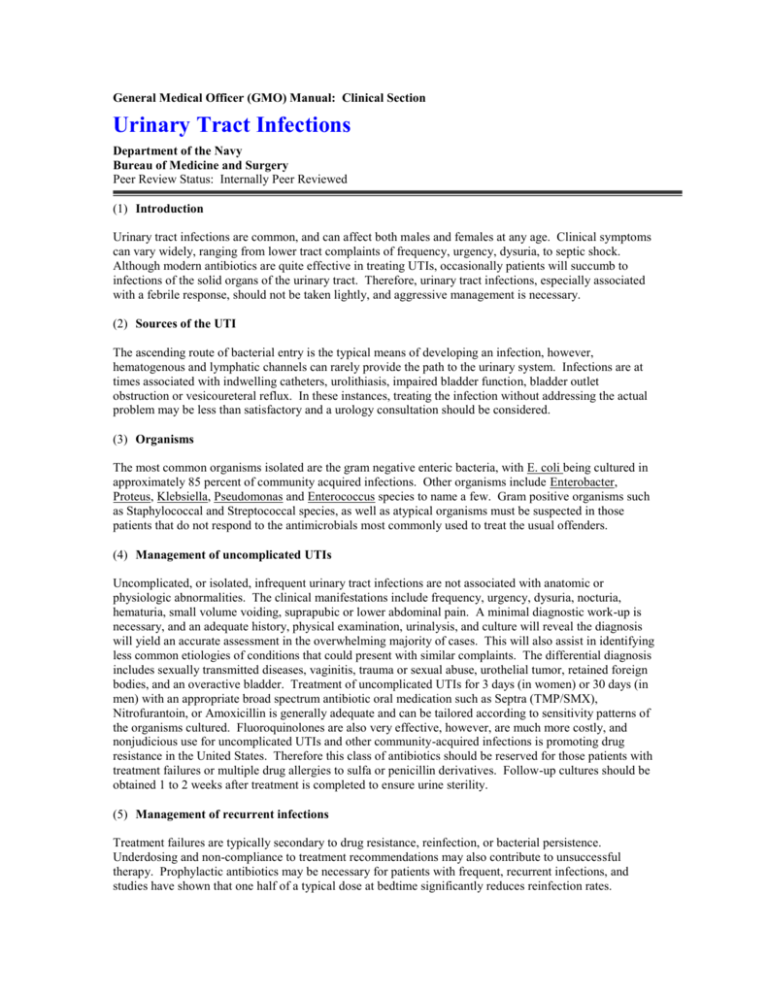
General Medical Officer (GMO) Manual: Clinical Section Urinary Tract Infections Department of the Navy Bureau of Medicine and Surgery Peer Review Status: Internally Peer Reviewed (1) Introduction Urinary tract infections are common, and can affect both males and females at any age. Clinical symptoms can vary widely, ranging from lower tract complaints of frequency, urgency, dysuria, to septic shock. Although modern antibiotics are quite effective in treating UTIs, occasionally patients will succumb to infections of the solid organs of the urinary tract. Therefore, urinary tract infections, especially associated with a febrile response, should not be taken lightly, and aggressive management is necessary. (2) Sources of the UTI The ascending route of bacterial entry is the typical means of developing an infection, however, hematogenous and lymphatic channels can rarely provide the path to the urinary system. Infections are at times associated with indwelling catheters, urolithiasis, impaired bladder function, bladder outlet obstruction or vesicoureteral reflux. In these instances, treating the infection without addressing the actual problem may be less than satisfactory and a urology consultation should be considered. (3) Organisms The most common organisms isolated are the gram negative enteric bacteria, with E. coli being cultured in approximately 85 percent of community acquired infections. Other organisms include Enterobacter, Proteus, Klebsiella, Pseudomonas and Enterococcus species to name a few. Gram positive organisms such as Staphylococcal and Streptococcal species, as well as atypical organisms must be suspected in those patients that do not respond to the antimicrobials most commonly used to treat the usual offenders. (4) Management of uncomplicated UTIs Uncomplicated, or isolated, infrequent urinary tract infections are not associated with anatomic or physiologic abnormalities. The clinical manifestations include frequency, urgency, dysuria, nocturia, hematuria, small volume voiding, suprapubic or lower abdominal pain. A minimal diagnostic work-up is necessary, and an adequate history, physical examination, urinalysis, and culture will reveal the diagnosis will yield an accurate assessment in the overwhelming majority of cases. This will also assist in identifying less common etiologies of conditions that could present with similar complaints. The differential diagnosis includes sexually transmitted diseases, vaginitis, trauma or sexual abuse, urothelial tumor, retained foreign bodies, and an overactive bladder. Treatment of uncomplicated UTIs for 3 days (in women) or 30 days (in men) with an appropriate broad spectrum antibiotic oral medication such as Septra (TMP/SMX), Nitrofurantoin, or Amoxicillin is generally adequate and can be tailored according to sensitivity patterns of the organisms cultured. Fluoroquinolones are also very effective, however, are much more costly, and nonjudicious use for uncomplicated UTIs and other community-acquired infections is promoting drug resistance in the United States. Therefore this class of antibiotics should be reserved for those patients with treatment failures or multiple drug allergies to sulfa or penicillin derivatives. Follow-up cultures should be obtained 1 to 2 weeks after treatment is completed to ensure urine sterility. (5) Management of recurrent infections Treatment failures are typically secondary to drug resistance, reinfection, or bacterial persistence. Underdosing and non-compliance to treatment recommendations may also contribute to unsuccessful therapy. Prophylactic antibiotics may be necessary for patients with frequent, recurrent infections, and studies have shown that one half of a typical dose at bedtime significantly reduces reinfection rates. Patients failing multiple adequate courses of antibiotics may need urinary tract imaging or functional studies to rule out complicating pathology. These may include intravenous urogram, computed tomography, magnetic resonance imaging, ultrasound, cystoscopy, or cystometrogram and can be done in coordination with a urologic consultation. (6) Management of complicated UTIs Complicated urinary tract infections pose a significant health risk and can result in increased morbidity and mortality if inadequately treated or if treatment is delayed. Acute pyelonephritis has historically been universally treated with intravenous antibiotics. Patients present with symptoms of fevers, chills, flank pain, pyuria, and bacteruria. The gram-negative organisms are again the most common organisms recovered, and treatment should be directed with broad-spectrum agents to empirically treat these bacteria until urine and blood culture and sensitivity results are available. Outpatient treatment has been proven safe for patients who are hemodynamically stable, and 14-day treatment is recommended. Patients with known anatomic or functional abnormalities require an additional 7 days of therapy to eradicate the infection. Non-responders to oral or parenteral medications, or those who’s condition deteriorates, should undergo upper tract imaging to rule out a perinephric abscess or obstructed collecting system, both of which require immediate drainage. (7) Pregnancy Pregnancy is associated with physiologic changes such as hydronephrosis, increased renal size, and anterosuperior bladder displacement, which increase the incidence of acute pyelonephritis when compared to non-pregnant females. This places the mother and unborn fetus at great risk for antenatal complications. Sepsis, preterm labor, infant prematurity, and fetal demise are outcomes that can be avoided with the routine use of screening urine cultures in asymptomatic gravid women and treating all with bacteruria. (8) Prostatitis Prostatitis is a common disorder, which accounts for approximately 25 percent of visits for men presenting for urologic evaluation of lower urinary tract symptoms. Most prostatitis is uncomplicated and can be treated adequately with a 30-day course of antibiotics as stated above. Acute febrile prostatitis accounts for less than five percent of all patients with prostatitis. Fevers, chills, rigors, frequency, urgency, dysuria, difficulty emptying the bladder, or even acute urinary retention are all common complaints. Temperature elevations to 1040 and a distended, tender lower abdomen are frequently encountered on physical examination. Prostate massage should be avoided in the acutely infected patient as this could result in severe pain, bacteremia, and unrecoverable urosepsis. Urine and blood cultures must be obtained before starting antibiotic therapy, and treatment should then begin empirically with broad spectrum agents such as ampicillin or vancomycin and an aminoglycocide until culture and sensitivity results are available. Hospitalization along with intravenous hydration, bladder drainage, and hemodynamic stabilization are imperative for the septic patient. Four weeks of treatment is required, however, most patients when afebrile and stable, can continue treatment with oral medications as an outpatient according to organism sensitivities. Persistent spiking fevers despite appropriate antibiotic coverage necessitates an investigation for a prostatic abscess, as antibiotics alone are typically inadequate. Surgical drainage by a urologist is necessary if an abscess is discovered. (9) Chronic Prostatitis Chronic prostatitis can be debilitating to those afflicted and is at times a difficult condition to treat. Diagnosis is made by demonstrating > 10 white blood cells per high powered field light microscopy and bacteria in the expressed prostatic secretions and VB3 urine culture. The VB3 (or voided bladder-3) specimen is obtained by collecting the first 5-10 milliliters of urine voided after a vigorous prostate massage. This will produce colony counts ten-fold higher than the midstream clean-catch specimen (VB2). Four to six week of treatment is successful in the majority of cases, TMP/SMX or a fluoroquinolone being the medications of choice due to their penetrability into the prostatic tissue. Treatment duration may be extended to 12 weeks and occasionally 6 months of once a day suppression if cure is not achieved with the initial treatment. Submitted by CAPT M. Melanie Haluszka, MC, USN, LCDR Brian K. Auge, MC, USN, and LT Timothy F. Donahue, MC, USNR, National Naval Medical Center, Bethesda (1999).

